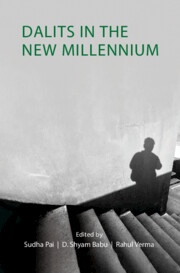Book contents
- Frontmatter
- Contents
- List of Figures
- List of Tables
- Acknowledgements
- 1 Introduction: Dalit Discourse in the New Millennium
- Part I Shifting Patterns of Electoral Politics
- 2 Voting Patterns among Dalits since the 1990s
- 3 On the Peculiar Absence of Dalit Politics: Punjab and West Bengal
- 4 Decline of the Bahujan Samaj Party: Dalit Politics under Right-Wing Hegemony
- 5 A Democratic Dilemma: Dalit Parties, Campaign Finance, and Coalition Politics
- 6 Why Are More Dalits Voting for the Bharatiya Janata Party since 2014?
- Part II Popular Culture, Discourse, and Protest
- Part III Transformations in Ideology and Identity
- Part IV Aspirations and Anxieties
- Part V Discrimination and Representation
- About the Contributors
- Index
6 - Why Are More Dalits Voting for the Bharatiya Janata Party since 2014?
from Part I - Shifting Patterns of Electoral Politics
Published online by Cambridge University Press: 12 July 2023
- Frontmatter
- Contents
- List of Figures
- List of Tables
- Acknowledgements
- 1 Introduction: Dalit Discourse in the New Millennium
- Part I Shifting Patterns of Electoral Politics
- 2 Voting Patterns among Dalits since the 1990s
- 3 On the Peculiar Absence of Dalit Politics: Punjab and West Bengal
- 4 Decline of the Bahujan Samaj Party: Dalit Politics under Right-Wing Hegemony
- 5 A Democratic Dilemma: Dalit Parties, Campaign Finance, and Coalition Politics
- 6 Why Are More Dalits Voting for the Bharatiya Janata Party since 2014?
- Part II Popular Culture, Discourse, and Protest
- Part III Transformations in Ideology and Identity
- Part IV Aspirations and Anxieties
- Part V Discrimination and Representation
- About the Contributors
- Index
Summary
One of the most noticeable and intriguing phenomena of the last decade is the increasing attraction of the Bharatiya Janata Party (BJP) as a political alternative for the Dalit castes. The massive mandate won by the BJP in 2014 and 2019 represents political realignment and a significant shift in society. One of the critical factors behind the continuing electoral dominance of the BJP is the successful inroads it has made among the Dalit castes (Kumar and Gupta, 2019). This chapter argues that the shift of Dalit voters towards the BJP is due to several long-term and short-term factors. One way to look at this phenomenon is to see the BJP as the beneficiary of a long-term fundamental shift in underlying socio-economic conditions. Another angle is to investigate the churning within the Dalit community. The chapter also looks at the strategy and tactics deployed by the BJP to attract voters from the Dalit castes.
Further, we must question if the present trend is sustainable. Will these long-term trends ultimately pull the party and Dalits apart, or are the BJP strategy and policies themselves creating instability in this relationship? In this chapter, we will explore the dynamics between Dalits and the BJP through the prism of these issues. Since it is not possible to do an overall analysis of Dalit politics for India due to the sheer diversity of the Dalit community and politics, the vantage point adopted is that of the Gangetic belt. The study is based on (a) secondary surveys and reporting and (b) interviews and interaction with BJP leaders and members, Dalit activists, and Dalit youth. For this purpose, several BJP parliamentarians, general secretaries, and other office-bearers were interviewed along with activists from the Dalit castes. While some of them are quoted in the chapter, most preferred not to be directly quoted.
Long-Term Changes
In the twenty-first century, India is undergoing several significant churns that will have a long-term impact on its future trajectory (Singh, 2019b). India is the most diverse country in the world with thousands of castes, tribes, and communities with different concerns and aspirations; therefore, the task of delineating all meta-trends is impossible.
- Type
- Chapter
- Information
- Dalits in the New Millennium , pp. 95 - 112Publisher: Cambridge University PressPrint publication year: 2023

